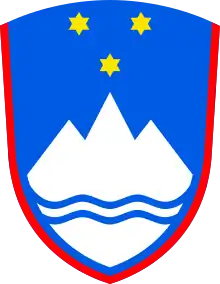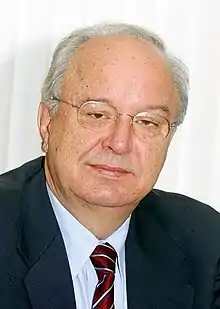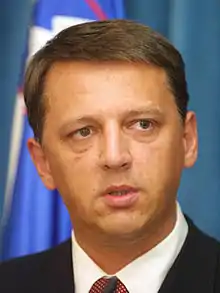Prime Minister of Slovenia
The prime minister of Slovenia, officially the president of the Government of the Republic of Slovenia (Slovene: Predsednik Vlade Republike Slovenije), is the head of the Government of the Republic of Slovenia. There have been nine officeholders since the country gained parliamentary democracy in 1989 and independence in 1991.
| President of the Government of the Republic of Slovenia
Predsednik Vlade Republike Slovenije | |
|---|---|
 | |
| Government of Slovenia Office of the Prime Minister | |
| Style | Mr. Prime Minister or President of the Government Slovene: Gospod predsednik vlade (formal) Mr. President Slovene: Gospod predsednik (informal) His Excellency Slovene: Njegova ekscelenca (in international correspondence and abroad only) |
| Type | Head of Government |
| Member of | Government of Slovenia European Council (EU) Euro summit (EU) National Security Council Also: North Atlantic Council (NATO) |
| Reports to | National Assembly of the Republic of Slovenia |
| Residence | None |
| Seat | Gregorčičeva 25 1000 Ljubljana Slovenia also: Predsedniška palača |
| Nominator | President of the Republic or MPs (second and third round of election only) |
| Appointer | National Assembly (with absolute majority) |
| Term length | No term limit Serves at the pleasure of the National Assembly. After a parliamentary election, resignation, removal from office or impeachment, the officeholder remains in office and leads a caretaker government until a new government is elected. |
| Constituting instrument | Constitution of Slovenia |
| Precursor | President of the Executive Council of the Assembly of the Socialist Republic of Slovenia |
| Formation | 16 May 1990 (de facto, following the first democratic election) 23 December 1991 (de jure, following adoption of the current Constitution of Slovenia) |
| First holder | Lojze Peterle as President of the Government |
| Unofficial names | Premier |
| Deputy | Deputy Prime Minister (not an official office, held by one or more members of the government) |
| Salary | € 76,586 annually[1] |
| Website | www |
 |
|---|
| This article is part of a series on the politics and government of Slovenia |
|
EU Member State |
|
Slovenia portal |
The prime minister of Slovenia is nominated by the president of the Republic after consultation with the parties represented in the National Assembly. He is then formally elected by a simple majority of the National Assembly. If no candidate receives a majority, a new vote must be held within 14 days. If no candidate receives a majority after this round, the President must dissolve the legislature and call new parliamentary elections unless the National Assembly agrees to hold a third round. If no candidate is elected after a third round, then the legislature is automatically dissolved pending new elections. In practice, since the appointee must command a majority of the National Assembly in order to govern, he or she is usually the leader of the majority party in the National Assembly or the leader of the senior partner in the governing coalition. The National Assembly can only withdraw its support from a prime minister by way of a constructive vote of no confidence–that is, a motion of no confidence is of no effect unless a prospective successor has the support of a majority. The prime minister is also the president of the National Security Council.
Election
The prime minister is elected by the National Assembly of Slovenia.
First round
Following the parliamentary election new National Assembly meets at the constitutive session (usually around 2-3 weeks after election; the president of the Republic convenes the session after receiving the official report on election from the State Election Commission), after which new parliamentary groups are officially formed. After all groups are formed (usually within few days), the president of the Republic meets with leaders of the groups for consultations. During the consultations, the president of the Republic tries to identify a candidate that could secure an absolute majority in the National Assembly (46 votes). After the consultations, the president of the Republic can officially propose a candidate to the president of the National Assembly, this has to be done within 30 days after the constitutive session. Assembly takes vote on the candidate within 7 days, but not earlier than 48 hours after proposal. Candidate has to present his vision of his government before the National Assembly before the vote. When a prime Minister is elected, the formation of a new government begins.
Second round
If there is no prime minister elected, the second round will take place. After new consultations, the president of the Republic can propose a new candidate or the same candidate again within 14 days of the first round vote. In the second round parliamentary groups and groups of 10 MPs can propose a candidate as well. Vote takes place no earlier than 48 hours from the proposal but not later than 7 days from it. If there are more candidates proposed, the National Assembly will first vote on the candidate proposed by the president of the Republic, only if that candidate is not elected, The assembly will take votes on other candidates in the order of submission of the proposals. A prime minister is elected with absolute majority (46 votes). When a prime minister is elected, formation of a new government begins.
If National Assembly once again fails to elect a Prime Minister, then President of the Republic will dissolve the National Assembly and call a snap election, unless the National Assembly decides, within 48 hours from the vote, to hold the third round of election.
Third round
In the third round, the prime minister is elected by a relative majority (majority of present MPs). Votes take place within 7 days from the decision but not earlier than 48 hours. In the third round, the National Assembly first votes on all the candidates from the first and second round, and if none of the candidates receives a majority of votes, then it will vote on new proposals, first on the proposal by the president of the Republic, then on the other in the order of submission. If a prime minister is elected formation of a new government begins, if not, the president dissolves the National Assembly and snap election takes place.
Oath of office
The prime minister officially takes office after all of his ministers take oath of office before the National Assembly, following the election of government with a relative majority in the National Assembly. The prime minister takes the oath of office after his election.
The prime minister and other ministers take the same oath of office according to the Article 104 of the Constitution: “I swear that I shall uphold the constitutional order, that I shall act according to my conscience and that I shall do all in my power for the good of Slovenia.”
List of prime ministers of Slovenia
Kingdom of Serbs, Croats and Slovenes
| No. | Portrait | Name (Birth–Death) |
Term of office | Political party | King of Kingdom of Serbs, Croats and Slovenes (reign) | |||
|---|---|---|---|---|---|---|---|---|
| Took office | Left office | Days | ||||||
| 1 |  |
Jožef Pogačnik (1866–1932) |
31 October 1918 | 20 January 1919 | 81 | Slovene People's Party |
Peter I  | |
Socialist Republic of Slovenia
Republic of Slovenia
| Christian democrats (2); SKD SLS NSi Liberals (5); LDS PS ZaAB SMC LMŠ National conservatives (1); SDS Social democrats (1); ZLSD / SD | ||||||||||||
|---|---|---|---|---|---|---|---|---|---|---|---|---|
| No. | Portrait | Name (Birth–Death) |
Term of office | Political party | Coalition | National Assembly | ||||||
| Took office | Left office | Days | ||||||||||
| 1 |  |
Lojze Peterle (born 1948) |
16 May 1990 | 14 May 1992 | 729 | SKD |
• | SKD–SDZS–SDZ–SLS–ZS | C (1990) | |||
| 2 |  |
Janez Drnovšek (1950–2008) |
14 May 1992 | 25 January 1993 | 2,946 | LDS | I | LDS–DS–SDS–SSS–ZS–ZLSD | 1 (1992) | |||
| 25 January 1993 | 27 February 1997 | II | LDS–SKD–SDS (1993–1994)–ZLSD (1993–1996) | |||||||||
| 27 February 1997 | 7 June 2000 | III | LDS–SLS–DeSUS | 2 (1996) | ||||||||
| 3 |  |
Andrej Bajuk (1943–2011) |
7 June 2000 | 4 August 2000 | 176 | SLS | • | SLS–SKD–SDS | ||||
| 4 August 2000 | 30 November 2000 | NSi | ||||||||||
| (2) |  |
Janez Drnovšek (1950–2008) |
30 November 2000 | 19 December 2002 | 749 | LDS | IV | LDS–SLS–DeSUS–ZLSD | 3 (2000) | |||
| 4 |  |
Anton Rop (born 1960) |
19 December 2002 | 3 December 2004 | 715 | LDS | • | LDS–SLS–DeSUS–ZLSD | ||||
| 5 |  |
Janez Janša (born 1958) |
3 December 2004 | 21 November 2008 | 1,449 | SDS | I | SDS–NSi–SLS–DeSUS | 4 (2004) | |||
| 6 |  |
Borut Pahor (born 1963) |
21 November 2008 | 10 February 2012 | 1,176 | SD | • | SD–DeSUS (2008–2011)–LDS–Zares (2008–2011) | 5 (2008) | |||
| (5) |  |
Janez Janša (born 1958) |
10 February 2012 | 20 March 2013 | 404 | SDS | II | SDS–NSi–SLS–DeSUS–DL | 6 ( 2011 ) | |||
| 7 | .jpg.webp) |
Alenka Bratušek (born 1970) |
20 March 2013 | 31 May 2014 | 547 | PS | • | PS–DeSUS–DL–SD–ZaAB | ||||
| 31 May 2014 | 18 September 2014 | ZaAB | ||||||||||
| 8 |  |
Miro Cerar (born 1963) |
18 September 2014 | 13 September 2018 | 1,456 | SMC | • | SMC–SD–DeSUS | 7 (2014) | |||
| 9 |  |
Marjan Šarec (born 1977) |
13 September 2018 | 13 March 2020 | 547 | LMŠ | • | LMŠ–SD–SMC–SAB–DeSUS | 8 (2018) | |||
| (5) |  |
Janez Janša (born 1958) |
13 March 2020 | Incumbent | 320 | SDS | III | SDS–SMC–DeSUS (2020–2021)–NSi | ||||
Timeline

Living former prime ministers
There are 6 former living prime ministers. Incumbent Prime Minister Janez Janša held the office between 2004-2008 and 2012-2013 as well. There were only two other prime ministers, Janez Drnovšek and Andrej Bajuk. Drnovšek died in 2008 and Bajuk in 2011.
Upon retirement former prime ministers do not receive any special honours or privileges. They are however entitled to a funeral with military honors.
Statistics
| No. | Prime Minister | Date of birth | Age at inauguration (first term) |
Time in office (total) |
Age at retirement (last term) |
Date of death | Longevity |
|---|---|---|---|---|---|---|---|
| 1 | Alojz Peterle | 5 July 1948 | 41 years, 315 days | 1 year, 364 days | 43 years, 314 days | Living | 72 years, 206 days (living) |
| 2 | Janez Drnovšek | 17 May 1950 | 41 years, 363 days | 10 years, 45 days | 52 years, 216 days | 23 February 2008 | 57 years, 282 days |
| 3 | Andrej Bajuk | October 18, 1943 | 56 years, 233 days | 176 days | 57 years, 43 days | 16 August 2011 | 67 years, 302 days |
| 4 | Anton Rop | 27 December 1960 | 41 years, 357 days | 1 year, 350 days | 43 years, 342 days | Living | 60 years, 31 days (living) |
| 5 | Janez Janša | 17 September 1958 | 46 years, 77 days | ongoing | Incumbent | Living | 62 years, 132 days (living) |
| 6 | Borut Pahor | 2 November 1963 | 45 years, 19 days | 3 years, 81 days | 48 years, 100 days | Living | 57 years, 86 days (living) |
| 7 | Alenka Bratušek | 31 March 1970 | 42 years, 354 days | 1 year, 182 days | 44 years, 171 days | Living | 50 years, 302 days (living) |
| 8 | Miroslav Cerar Jr. | 25 August 1963 | 51 years, 24 days | 3 years, 360 days | 55 years, 19 days | Living | 57 years, 155 days (living) |
| 9 | Marjan Šarec | 2 December 1977 | 40 years, 285 days | 1 year, 182 days | 42 years, 102 days | Living | 43 years, 56 days (living) |
Deputy prime minister
Deputy prime minister is an unofficial title given to certain ministers in the government (usually leaders of coalition parties other than that from which prime minister comes). Deputy prime minister does not have any additional duties to those that come with the office of minister. There are usually multiple deputy prime ministers in each government.
List of deputy prime ministers
| Government | Deputy Prime Ministers | Took office | Left office | |||
|---|---|---|---|---|---|---|
| Prime Minister | Name | Party | Other functions in the government | |||
| I | Mitja Malešič | None; responsible for social activities | 16 May 1990 | 14 May 1992 | ||
| Jože Mencinger | None; responsible for economy | 16 May 1990 | 8 May 1991 | |||
| Andrej Ocvirk | None; responsible for economy | 8 May 1991 | 14 May 1992 | |||
| Leopold Šešerko | None; responsible for environment and regional development | 16 May 1990 | 14 May 1992 | |||
| II | Jože Pučnik | SDSS | None | 14 May 1992 | 25 January 1993 | |
| Herman Rigelnik | LDS | None | 14 May 1992 | 25 January 1993 | ||
| Viktor Žakelj | LDS | None | 14 May 1992 | 25 January 1993 | ||
| X | Radovan Žerjav | SLS | Minister of Economic Development and Technology | 10 February 2010 | 25 February 2013 | |
| Karl Erjavec | DeSUS | Minister of Foreign Affairs | 10 February 2010 | 22 February 2013 | ||
| Ljudmila Novak | NSi | Minister without portfolio for Slovenians Abroad | 10 February 2010 | 20 March 2013 | ||
| XI | Dejan Židan | SD | Minister of Agriculture, Forestry and Food | 20 March 2013 | 18 September 2014 | |
| Gregor Virant | DL | Minister of the Interior and Public Administration | 20 March 2013 | 18 September 2014 | ||
| Karl Erjavec | DeSUS | Minister of Foreign Affairs | 20 March 2013 | 18 September 2014 | ||
| XII | Boris Koprivnikar | SMC | Minister of Public Administration | 18 September 2014 | 13 September 2018 | |
| Karl Erjavec | DeSUS | Minister of Foreign Affairs | 18 September 2014 | 13 September 2018 | ||
| Dejan Židan | SD | Minister of Agriculture, Forestry and Food | 18 September 2014 | 13 September 2018 | ||
| XIII | Andrej Bertoncelj | LMŠ | Minister of Finance | 13 September 2018 | 13 March 2020 | |
| Jernej Pikalo | SD | Minister of Education, Science and Sport | 13 September 2018 | 13 March 2020 | ||
| Miro Cerar | SMC | Minister of Foreign Affairs | 13 September 2018 | 13 March 2020 | ||
| Alenka Bratušek | SAB | Minister of Infrastructure | 13 September 2018 | 13 March 2020 | ||
| Karl Erjavec | DeSUS | Minister of Defence | 13 September 2018 | 13 March 2020 | ||
| XIV | Zdravko Počivalšek | SMC | Minister of Economic Development and Technology | 13 March 2020 | Incumbent | |
| Matej Tonin | NSi | Minister of Defence | 13 March 2020 | Incumbent | ||
| Aleksandra Pivec | DeSUS | Minister of Agriculture, Forestry and Food | 13 March 2020 | Incumbent | ||
References
- "IG.com Pay Check". IG.

.jpg.webp)
.jpg.webp)
.jpg.webp)


.jpg.webp)
.jpg.webp)

.jpg.webp)

